| Columns Retired Columns & Blogs |
Comply Foam Tips and the Effects of Tip Selection

This story originally appeared at InnerFidelity.com
The Trouble with Tips
Numerous people have asked me to investigate how ear tips affect the frequency response of in-ear monitors (IEMs). Personally, I've not experienced much change in tone when changing from one tip type to another, but I've had plenty of troubles with ear tips in general.
My left ear has a significantly more acute bend in it's ear canal than my right ear. Many times the ear tip bottoms out at the bend and the opening of the ear tip gets pushed against the wall of the canal occluding the opening and muffling the sound. Deep seating IEMs--like the Etymotic ER4P--often will put terrible pressure on the ear canal as it tries to straighten it out, which can be quite uncomfortable. Even custom molded in-ear monitors can be quite difficult to get into my left ear. What I've learned is that getting a comfortable and quality seal in my ears can be quite difficult. I've also learned that with care and experimentation most of these problems can be overcome.
The biggest problem, it seems to me, is that most IEMs come with a limited selection of tips--usually just small, medium, and large round silicon tips. Sometimes one will work, and sometimes not. Fortunately, I've got a pretty big selection of tips lying about and I can usually find one that works. But for most folks, that's not really an option. Enter Comply.
Started in 1990 by Dr. Robert Oliveira, Comply is a spin-off from work done at 3M. Dr. Oliveira is a specialist in the human hearing system and has done significant research in the changing shape of the ear canal with mouth movement. He came to the conclusion that dynamic memory foam is an ideal material for ear tips. At this point, Comply has developed a range of tips that will fit most commercially available in-ear headphones.
I've found that the Comply tips are the most reliably comfortable ear tips available, and they provide excellent isolation. But I've also found numerous complaints online about these tips changing the frequency response of the earphones. I thought it would be cool to look into the effects of ear tip selection on frequency response.
The Effects of Tip Selection on Frequency Response
I decided to try three different headphones: the Etymotic ER4P, which seats deeply within the ear; the Monster Turbine Pro Gold, which doesn't sit in the ear very well as it's heavy and rather large; and the Audeo PFE Gold, which is ergonomically excellent and seats at a moderate depth. All these headphones perform fairly well, and I felt they should be responsive enough to give me good data. I measured these IEMs with all the stock tips that fit my dummy head, and the recommended Comply tip for each headphone.
I should mention here that the dummy's ear canals, while acoustically very similar to human ear canals, are not physically like human ear canals. Human ear canals usually have a bend, and not perfectly round in cross section; the dummy ear canals are straight and perfectly circular in cross section.
Etymotic ER4PT
I think Etymotic has one of the better tip selections available, and I was able to use three different Etymotic tips. In the photo at the top of the page, the leftmost IEM is the ER4PT, and the tips used are below it: the silicon triple flange; the Glider, which is a dense memory foam; the less dense Etymotic memory foam tip, and the Comply tip.
Here are the Left and Right channel frequency response plots with all four tips:
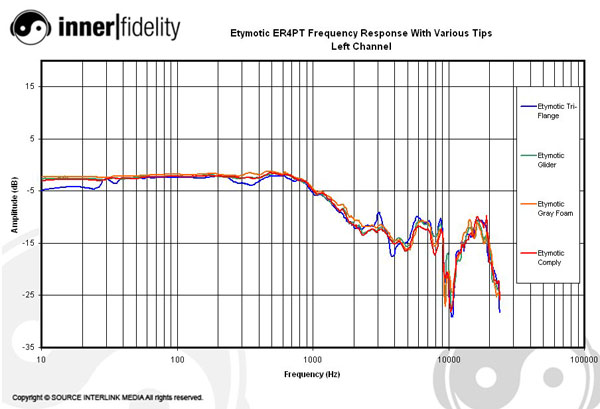
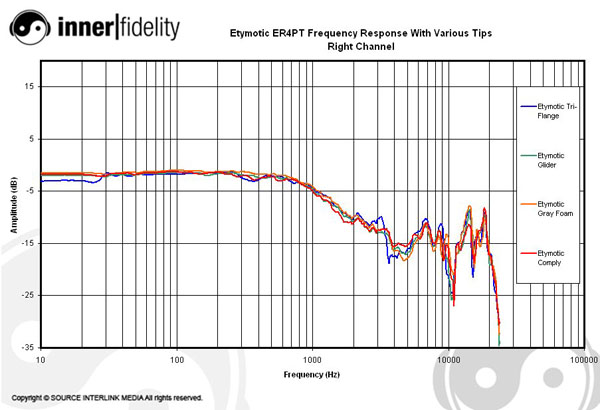
Here we can see in both the left and right ear measurements very little difference in response with the various tips. The notable exception is the triple flange tip which deviates in the very low bass, and at around 3-4kHz. The change in the bass response is similar to what is seen with the "main spring" effect on full size, sealed headphones. My guess is that the longer tube of the tri-flange type tip and its greater mass of elastic silicon create a mechanical resonance in the tip that causes the dip.
Monster Turbine Gold
Although these come with a wide variety of tips, I could only find two that would effectively seat in the ear canal of the dummy.
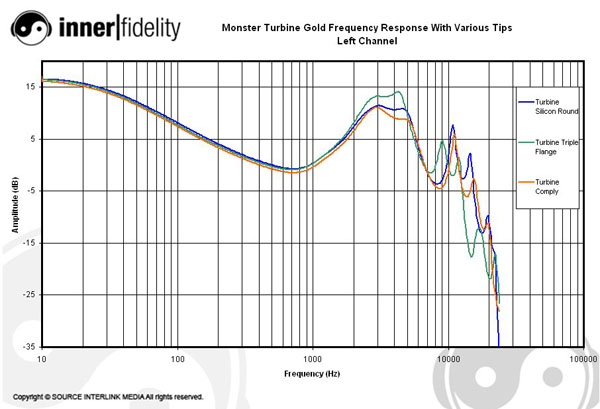
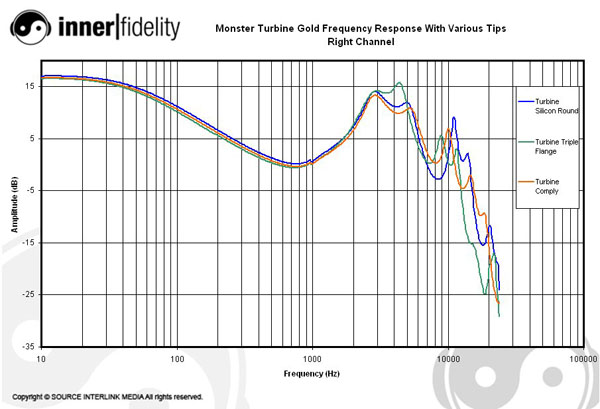
Results of the left and right ear are a little mixed, but it's clear that the triple flange tip results are the most disparate. The Monster triple flange tip is somewhat larger and longer than the Etymotic triple flange, and has less support from the nozzle of the earphone than that of the Etymotic. The Comply tip does seem to slightly reduce the high frequencies above 10kHz, but I would say this is a relatively negligible amount. Certainly not large enough to account for some of the vehement complaints of loss of highs sometimes reported.
Audeo PFE Gold
The Audeo tip selection is small, and only one silicon tip fit the dummy.
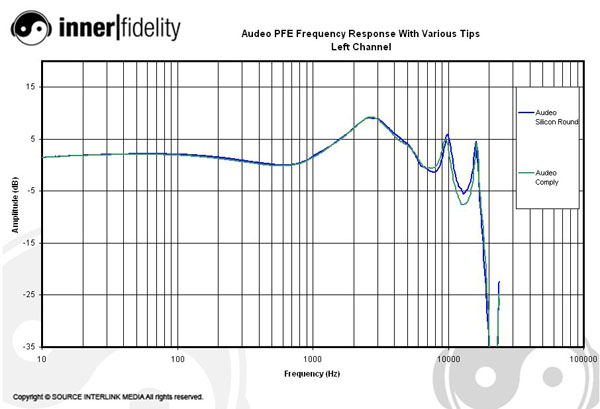
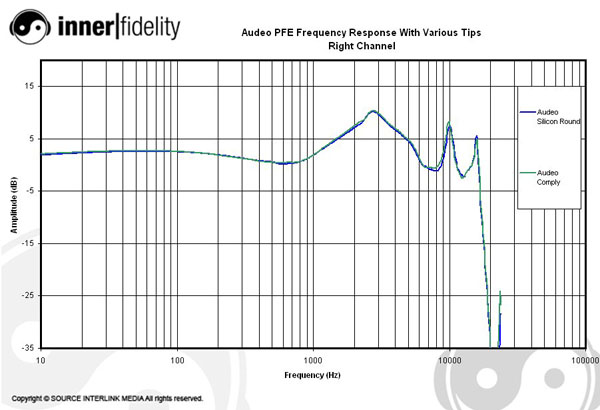
Here we can see the Comply tip had no effect on the right channel, and only a small effect on the left channel above 10kHz relative to the stock silicon round tip.
Measurement Results
It seems clear to me that the Comply tips are not affecting the sound substantially. In fact, it seem the triple flange tip types are more likely to cause changes in response.
So, the question remains: Why do people complain of Comply tips sounding muffled?
I think I have one possible answer ...
- Log in or register to post comments




































